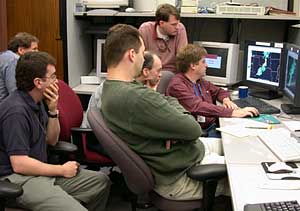


Members of a forecast team evaluate deterministic model output during a typical SPC/NSSL Spring Experiment.
NEW! 2008 Spring Experiment Home Page
The Hazardous Weather Testbed in Norman rose up from a grassroots level after the Storm Prediction Center (SPC) moved its operations to the National Severe Storms Laboratory (NSSL) facility in 1997. The mutual interests of forecasters from the SPC, researchers from NSSL, and collocated joint research partners from the Cooperative Institute for Mesoscale Meteorological Studies (CIMMS) inspired the formation of the HWT. The testbed's activities have been varied, ranging from daily map discussions involving imminent severe weather to loosely-related research projects involving 2-3 collaborators to periodic intensive collaboration periods.
The cornerstone of the testbed is the SPC/NSSL Spring Program, a series
of annual experiments that attracts 50-60 researchers and forecasters to
Norman each year. The premise of each Spring
Experiment ![]() ,
and related activities such as the 2005
Summer Experiment, is
to provide forecasters with a first-hand look at the latest research concepts
and products, while immersing research scientists in the challenges, needs,
and constraints of front-line forecasters. In practice, this program gives
forecasters direct access to the latest research developments while imparting
scientists with the knowledge to formulate research strategies that will
have practical benefits. The end result is not only better severe-weather
forecasts, but important contributions to the scientific literature as well.
,
and related activities such as the 2005
Summer Experiment, is
to provide forecasters with a first-hand look at the latest research concepts
and products, while immersing research scientists in the challenges, needs,
and constraints of front-line forecasters. In practice, this program gives
forecasters direct access to the latest research developments while imparting
scientists with the knowledge to formulate research strategies that will
have practical benefits. The end result is not only better severe-weather
forecasts, but important contributions to the scientific literature as well.
As the Norman meteorological community consolidates its diverse workforce in a common building, numerous groups are adopting the collaborative spirit and innovative approach of the HWT. At the same time, the HWT is expanding to embrace these groups and provide the framework for development and implementation of new technologies in different areas, particularly those focusing on shorter-timescale forecasting challenges. For example, NSSL's Severe Weather Warning Applications and Technology Transfer (SWAT) team and the NWS Norman WFO are stepping into important contributing roles within the HWT.
We anticipate that the proof of concept established through the annual NSSL/SPC Spring Experiment and the early years of the HWT will play an important role in bringing together the diverse elements of the Norman meteorological community and like-minded meteorologists from across the country. In fact, Congress recently provided seed funding to help foster a collaboration between the HWT, the University of Alabama at Huntsville, and NASA's Short-term Prediction Research and Transition center (SPoRT), a joint center staffed by NASA research meteorologists also located in Huntsville, and the Huntsville WFO. This new partnership capitalizes on the uncommon passion in both of these communities for operationally relevant research and the rapid infusion of research results into operations. These efforts provide unique and valuable contributions to our understanding and prediction of hazardous convective weather events, leading to improved severe-thunderstorm and tornado watches and warnings for the public.
Key PUBLICATIONS from HWT Collaborations
SUMMARIES of previous SPC/NSSL Spring Experiments:
2007200520042003200220012000
For more information on the NOAA Hazardous Weather Testbed, email Jack Kain or Steve Weiss.